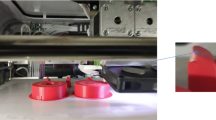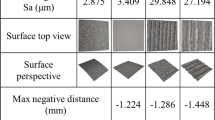Abstract
In the past few years, a new generation of additive manufacturing (AM) techniques has rapidly become available due to the expiration of some AM patents which allowed significant cost reductions. This article explores some available techniques fostering products innovation in experimental laboratories for the development of naval propulsion, where high costs represent an important limitation for both basic research and industrial testing, by identifying significant knowledge and variables and by providing reliable and accurate data to support designers and researchers. The propeller INSEAN E779a case study was taken into account and fabricated by direct metal laser sintering in AlSi10Mg aluminium alloy and by fused deposition modeling in acrylonitrile–butadiene–styrene, and UltraT polymeric materials. The study of printing parameters, flexural tests, differential scanning calorimetry and thermogravimetric analysis, allowed to optimize the printing process conditions. A reverse engineering system, Faro-CAM2, and the iterative closest point algorithm of the geomagic control software were used to analyse deviations from the printed propeller and the CAD nominal model. The atomic force microscopy test allowed to assess the morphological features and surface roughness of printed propellers. Towing Tank tests were carried out and the hydrodynamic performance comparison was analysed in terms of torque and drag. The results of this study show differences between the benchmark and AM propellers, as a function of the advance coefficient J, the morphological characteristics and the materials. However this study also shows a substantial adequacy of AM propellers in most studies carried out in Towing Tank.




























Similar content being viewed by others
References
ASTM F2792–10.: Standard terminology for additive manufacturing. In: ASTM international committee F42 on additive manufacturing. ASTM, West Conshohocken (2009)
Fantini, M., De Crescenzio, F., Ciocca, L.: Design and rapid manufacturing of anatomical prosthesis for facial rehabilitation. Int. J. Interact. Des. Manuf. (IJIDeM) 7(1), 51–62 (2013)
Laverne, F., Segonds, F., D’Antonio, G., Le Coq, M.: Enriching design with X through tailored additive manufacturing knowledge: a methodological proposal. Int. J. Inter. Des. Manuf. (IJIDeM), 1–10 (2016)
ITTC.: Testing and extrapolation methods: propulsion, performance propulsion test. In: Tech. Rep. 7.5-02-03-01.1. International Towing Tank Conference (2002)
ITTC.: Testing and extrapolation methods: propulsion, propulsor open water test. In: Tech. Rep. 7.5-02-03-02.1. International Towing Tank Conference (2002)
Lanzotti, A., Del, Giudice, D., Lepore, A., Staiano, G., Martorelli, M., : On the geometric accuracy of RepRap open-source three-dimensional printer. J. Mech. Des. Trans. ASME 137(1), 101703-1–101703-8 (2015)
Lanzotti, A., Grasso, M., Staiano, G., Martorelli, M., The impact of process parameters on mechanical properties of parts fabricated in PLA with an open-source 3-D printer. Rapid Prototy. J. 21, 604–607 (2015)
Lanzotti, A., Martorelli, M., Staiano, G.: Understanding process parameter effects of reprap open-source three-dimensional printers through a design of experiments approach. J. Manuf. Sci. Eng. 137(1), 011017-1–011017-7 (2015)
Khaing, M.W., Fuh, J., Lu, L.: Direct metal laser sintering for rapid tooling: processing and characterization of EOS parts. J. Mate. Process. Technol 113, 269–272 (2001)
Simchi, A., Petzoldt, F., Pohl, H.: On the development of direct metal laser sintering for rapid tooling. J. Mater. Process. Technol 141, 319–328 (2003)
Khaing, M.W., Fuh, J., Lu, L.: Direct metal laser sintering. J. Mater. 113, 269–272 (2001)
Senthilkumaran, K., Pandey, P.M., Rao, P.V.M.: Influence of building strategies on the accuracy of parts in selective laser sintering. Mater. Des. 30(8), 2946–2954 (2009)
Song, Y.A., Koenig, W.: Experimental study of the basic process mechanism for direct selective laser sintering of low-melting metallic powder. CIRP Ann. Manuf. Technol. 46(1), 127–130 (1997)
Delgado, J., Ciurana, J., Rodrıguez, C.A.: Influence of process parameters on part quality and mechanical properties for DMLS and SLM with ron-based materials. Int. J. Adv. Manuf. Technol. 60(5–8), 601–610 (2012)
Wong, M., Owen, I., Sutcliffe, C.J., Puri, A.: Convective heat transfer and pressure losses across novel heat sinks fabricated by selective laser melting. Int. J. Heat Mass transfer 52(1–2), 281–288 (2009)
Calignano, F., Manfredi, D., Ambrosio, E.P., Iuliano, L., Fino, P.: Influence of process parameters on surface roughness of aluminum parts produced by DMLS. Int. J. Adv. Manuf. Technol. 67(9–12), 2743–2751 (2013)
Read, N., Wang, W., Essa, K., Attallah, M.: Selective laser melting of AlSi10Mg: process optimisation and mechanical properties development. Mater. Des. 65, 417–424 (2015)
ASTM-D3417.: Standard test method for enthalpies of fusion and crystallization of polymers by differential scanning calorimetry (DSC). ASTM International, West Conshohocken (1999)
ASTM-D3418.: Standard test method for transition temperatures and enthalpies of fusion and crystallization of polymers by differential scanning calorimetry. ASTM International, West Conshohocken (2015)
ASTM-D790.: Standard test methods for flexural properties of unreinforced and reinforced plastics and electrical insulating materials. ASTM International, West Conshohocken (2002)
Besl, P.J., McKay, N.D.: A method for registration of 3-D shapes. IEEE Trans. Pattern Anal. Mach. intell. 14(2), 239–256 (1992)
Gerbino, S., Del Giudice, D., Staiano, G., Lanzotti, A., Martorelli, M.: On the influence of scanning factors on the laser scanner-based 3D inspection process. J. Adv. Manuf. Technol. 84, 1787–1799 (2015)
Liu, P., Bose, N., Frost, R., Macfarlane, G., Lilienthal, T., Penesis, I.: Model testing and performance comparison of plastic and metal tridal turbine rotors. Appl. Ocean Res. 53, 116–124 (2015)
Breteau, T., Damay, T., Duc, E., Hascoët, J.Y.: Design for manufacturing with tool paths adapted to marine propeller. Int. J. Inter. Des. Manuf. (IJIDeM) 5, 271–275 (2011)
Acknowledgements
The authors acknowledge the support received by MBDA s.p.a. Italy and by INSEAN.
Author information
Authors and Affiliations
Corresponding author
Rights and permissions
About this article
Cite this article
Staiano, G., Gloria, A., Ausanio, G. et al. Experimental study on hydrodynamic performances of naval propellers to adopt new additive manufacturing processes. Int J Interact Des Manuf 12, 1–14 (2018). https://doi.org/10.1007/s12008-016-0344-1
Received:
Accepted:
Published:
Issue Date:
DOI: https://doi.org/10.1007/s12008-016-0344-1




